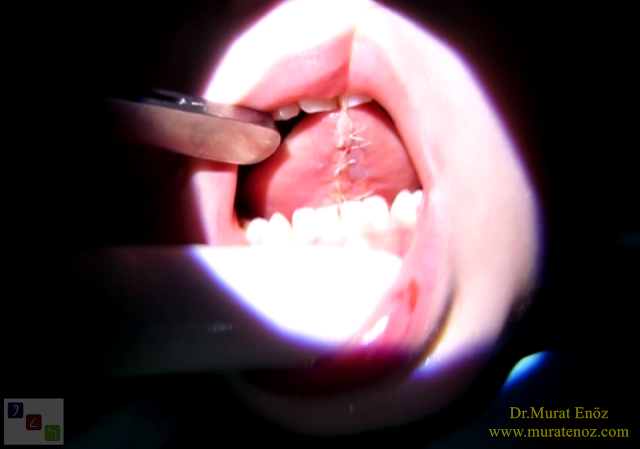Lingual Frenectomy With Thermal Welding System
In infants and children, the tongue tie may partially re-adhere and re-functional tongue tie may occur due to the lack of adequate amount of tongue tie massage and tongue exercises after lingual frenectomy or rapid mucosal healing properties (improvement in oral mucosal damage from the outside to the center).
Here, the removal of the tongue tie tissue with using thermal welding device is showing. A curtain-shaped structure under the tongue is removed and it is aimed to decrease the possibility of lining of the wound edges.
Video descriptions:
• The procedure is performed under sedation anesthesia
• The mixture of saline and local anesthetic is injected into the tongue tie a
• A triangular area is marked on the tongue ligament with the aid of a clamp
• Triangle shaped tongue tie tissue resected with using of the thermal welding device
• Local anesthetic is injected back into the incision site
• The incision line is sutured with thin absorbale stitch materials
• Bleeding control is performed and the operation is terminated
Differences and technical details:
- Tie tissue is removed, the risk of adhesion between wound lips is falling
- is not easy to apply to babies in office conditions (tongue tie is easier to cut)
- It is very easy and not suitable for patients with posterior tongue tie.
- the area to be removed is demineralised by first using a hemostat and then cut with the help of scissors, laser, electrocautery or thermal welding device.
- local anesthetic spray and injection of a local anesthetic drug prior to the procedure is necessary for the patient to feel the pain.
- care must be taken not to damage the lower jaw salivary gland and opening mouth during the procedure
- general care advice and what to do after the procedure, as in the conventional classical tongue tie cutting (no difference).
Here, the removal of the tongue tie tissue with using thermal welding device is showing. A curtain-shaped structure under the tongue is removed and it is aimed to decrease the possibility of lining of the wound edges.
Video descriptions:
• The procedure is performed under sedation anesthesia
• The mixture of saline and local anesthetic is injected into the tongue tie a
• A triangular area is marked on the tongue ligament with the aid of a clamp
• Triangle shaped tongue tie tissue resected with using of the thermal welding device
• Local anesthetic is injected back into the incision site
• The incision line is sutured with thin absorbale stitch materials
• Bleeding control is performed and the operation is terminated
Differences and technical details:
- Tie tissue is removed, the risk of adhesion between wound lips is falling
- is not easy to apply to babies in office conditions (tongue tie is easier to cut)
- It is very easy and not suitable for patients with posterior tongue tie.
- the area to be removed is demineralised by first using a hemostat and then cut with the help of scissors, laser, electrocautery or thermal welding device.
- local anesthetic spray and injection of a local anesthetic drug prior to the procedure is necessary for the patient to feel the pain.
- care must be taken not to damage the lower jaw salivary gland and opening mouth during the procedure
- general care advice and what to do after the procedure, as in the conventional classical tongue tie cutting (no difference).
Search result link where you can read articles published by Dr. Murat Enoz on this website about Tongue tie (you can reach other articles by clicking on more posts at the end of the page) >> https://www.ent-istanbul.com/search?q=Tongue+tie
Murat Enoz, MD, Otorhinolaryngology, Head and Neck Surgeon - ENT Doctor in Istanbul
Private Office:
Address: İncirli Cad. No:41, Kat:4 (Dilek Patisserie Building), Postal code: 34147, Bakırköy - İstanbul
Appointment Phone: +90 212 561 00 52
Appointment Phone: +90 212 561 00 52
Fax: +90 212 542 74 47










Comments
Post a Comment